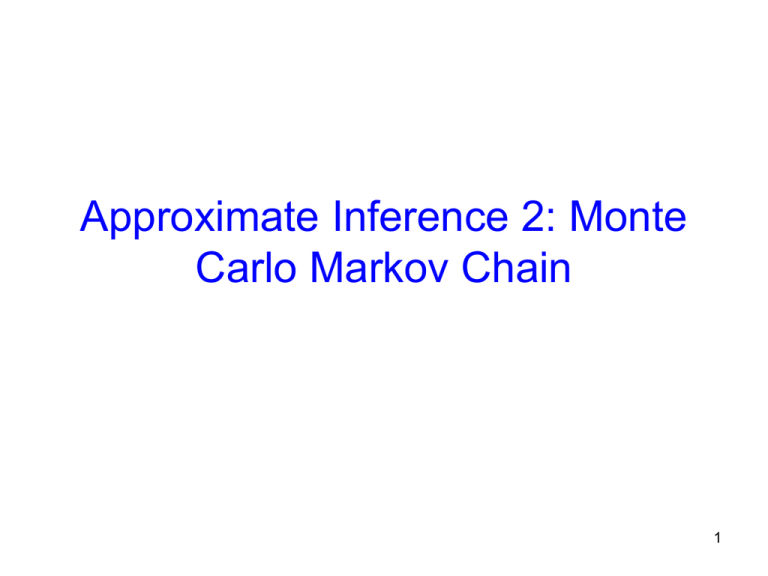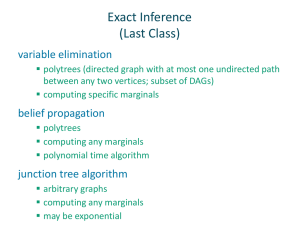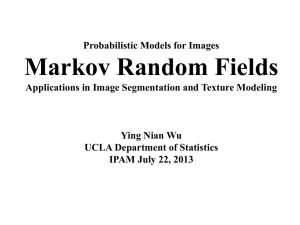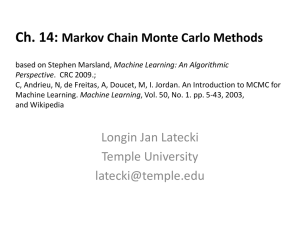Document
advertisement

Approximate Inference 2: Monte
Carlo Markov Chain
1
MCMC
Limitations of LW:
• Evidence affects sampling only for nodes
that are its descendants
• For nondescendants, the weights account
for the effect of the evidence
• If evidence is at the leaves, we are
sampling from the prior distribution (and
not the posterior which is what we want)
MCMC
Strategy used by MCMC
• Generate a sequence of samples
• Initial samples generated from the prior
• Successive samples generated
progressively closer to the posterior
Applies to both directed and undirected models.
We’ll use a distribution P defined in terms of a
set of factors
Gibbs Sampling
Gibbs Sampling
Example: Suppose we have as evidence SAT = High and
Letter = Weak (nodes are shaded grey)
Difficulty
Intelligence
Factors:
• P(I)
Grade
Letter
SAT
• P(D)
• P(G | I,D)
Reduced Factors:
• P(S=high | I)
• P(L=weak | G)
Gibbs Sampling
Difficulty
Intelligence
Grade
SAT
Letter
Start with an initial sample eg: x(0) = (D = high, I = low, G =
B, S = high, L = weak)
• D, I and G could be set in any way, for instance by forward
sampling, to get D(0) = high, I(0) = low, G(0) = B
• S and L are observed
Gibbs Sampling
Difficulty
Intelligence
Grade
Letter
SAT
Resample non-evidence nodes,
one at a time, in some order eg.
G, I, D.
If we sample Xi, keep other nodes
clamped at the values of the
current state (D = high, I = low,
G = B, S = high, L = weak)
To sample G(1), we compute P(G | D=high, I=low):
P ( G | D high , I low )
P ( I high ) P ( D low ) P ( G | I low , D High ) P ( L low | G ) P ( S high | I low )
P(I
high ) P ( D low ) P ( G | I low , D High ) P ( L low | G ) P ( S high | I low )
G
P ( G | I low , D high ) P ( Letter weak | G )
P (G | I
G
low , D high ) P ( Letter weak | G )
Gibbs Sampling
Difficulty
Intelligence
Grade
SAT
• Suppose we obtain G(1) = C.
• Now sample I(1) from P(I |
D=high, G=C). Note it is
conditioned on G(1)=C
• Say we get I(1)=high
Letter
• Now sample D(1) from P(D |
G=C, I = high). Say you get D(1)
= high
• The first iteration of sampling
produces x(1) = (I = high, D =
high, G = C)
• Iterate...
Gibbs Sampling
• P(G | D=high, I=low) takes downstream
evidence L=weak into account (makes it closer
to the posterior distribution P(X | e))
• Early on, P(G | D=high, I=low) very much like
the prior P(X) because it uses values for I and D
sampled from P(X)
• On next iteration, resampling I and D
conditioned on new value of G brings the
sampling distribution closer to the posterior
• Sampling distribution gets progressively closer
and closer to the posterior
Gibbs Sampling
1.
2.
3.
4.
5.
6.
7.
Procedure Gibbs-Sample (
X
// Set of variables to be sampled
// Set of factors defining P
P(0)(X), // Initial state distribution
T
// Number of time steps
)
Sample x(0) from P(0)(X)
for t=1, ..., T
x(t) x(t-1)
for each Xi X
Sample xi(t) from P(Xi | x-i)
// Change Xi in x(t)
return x(0), ..., x(T)
Gibbs Sampling
Gibbs sampling with evidence
• Reduce all factors by the observations e
• The distribution P corresponds to P(X|e)
Markov Chains
Markov Chains
• (Informally) A Markov chain is a graph of
states over which the sampling algorithm
takes a random walk
• Note: the graph is not the graphical model
but a graph over the possible assignments
to a set of variables X
Markov Chains
• A Markov chain is defined via a state space
Val(X) and a model that defines, for every state
x Val(X) a next-state distribution over Val(X).
• More precisely, the transition model T specifies
for each pair of states x, x’ the probability T(x
x’) of going from x to x’.
• A homogeneous Markov chain is one where the
system dynamics do not change over time
Markov Chains
Example of a Markov Chain with Val(X)={A,B,C}:
State Transition Diagram View
0.25
A
0.75
0.5
0.4
C
B
0.5
0.6
Conditional Probability Distribution
View
Xt-1
Xt
P(Xt|Xt-1)
A
A
0.25
A
B
0
A
C
0.75
B
A
0.5
B
B
0.5
B
C
0
C
A
0.4
C
B
0.6
C
C
0
Markov Chains
• Random sampling process defines a random
sequence of states x(0), x(1), x(2), …
• X(t) is a random variable:
• Need initial state distribution P(0)(X(0))
• Probability that next state is x’ can be computed
as:
P
( t 1)
(X
( t 1)
x')
P
(t )
(X
(t )
x )T ( x x ' )
x Val ( X )
Sum over all states that the chain
could have been at time t
Probability of transition from x to x’
Markov Chains
How to generate a Markov Change Monte Carlo trajectory:
Procedure MCMC-Sample (
P(0)(X), // Initial state distribution
T,
// Markov chain transition model
T
// Number of time steps
)
1.
2.
3.
4.
Sample x(0) from P(0)(X)
for t = 1, …, T
Sample x(t) from T(x(t-1) X)
return x(0), …, x(T)
The big question: does P(t) converge and what to?
Markov Chains
• When the process converges, we expect:
P
(t )
( x') P
( t 1)
( x')
P
(t )
( x )T ( x x ' )
x Val ( X )
• A distribution (X) is a stationary distribution for
a Markov chain T if it satisfies:
( X x')
(X
x )T ( x x ' )
x Val ( X )
• A stationary distribution is also called an
invariant distribution
Markov Chains
Another example:
To find the stationary distribution:
0.7
0.25
(x1) = 0.25(x1)+0.5(x3)
(x2) = 0.7(x2)+0.5(x3)
X1
(x3) = 0.75(x1)+0.3(x2)
X2
(x1) + (x2) + (x3) = 1
0.75
0.5
0.5
X3
0.3
Solving these simultaneous equations
gives: (x1) = 0.2, (x2) = 0.5, (x3) =
0.3
Markov Chains
• Bad news: no guarantee that MCMC
sampling process converges to a
stationary distribution
• Example:
1.0
X1
X2
1.0
Markov Chains
• No guarantee that stationary distribution is
unique – depends on P(0)
– This happens if the chain is reducible: has
states that are not reachable from each other
• We will restrict our attention to Markov
chains that have a stationary distribution
which is reached from any starting
distribution P(0)
Markov Chains
• To meet this restriction, we need the chain
to be regular
• A Markov chain is said to be regular if
there exists some number k such that, for
every x, x’ Val(X), the probability of
getting from x to x’ in exactly k steps is > 0
• Theorem 12.3: If a finite state Markov
chain T is regular, then it has a unique
stationary distribution
Markov Chains
• Define Ti to be a transition model called a
kernel
• For graphical models, define a kernel Ti
for each variable Xi X
• Define X-i = X – {Xi} and let xi denote an
instantiation to Xi
• The model Ti takes a state (x-i, xi) and
transitions to a state (x-i, xi’)
Gibbs Sampling Revisited
Gibbs Sampling Revisited
How do we use MCMC on a graphical model?
• Want to generate samples from the posterior
P(X|E=e) where X=X - E
• Define a chain where P(X|e) is the stationary
distribution
• States are instantiations x to X – E
• Need transition function that converges to
stationary distribution P(X|e)
• For convenience: define P = P(X|e) where the
factors in are reduced by the evidence e
Gibbs Sampling Revisited
Using the MCMC framework, the transition
model for Gibbs Sampling is:
T i (( x i , x i ) ( x i , x )) P ( x | x i )
'
i
'
i
And the posterior distribution P(X) = P(X|e)
is a stationary distribution of this process
Gibbs Sampling Revisited
Example: Gibbs sampling on the Markov blanket
of Xi :
P ( X )
1
Z
1
Z
j: X i D j
j
j
(D j )
j
(D j )
j
(D j )
j: X i D j
Define xj,-i to be the assignment in x-i to Dj – {Xi}.
Note that if Xi Dj, xj,-i is a full assignment to Dj.
Gibbs Sampling Revisited
1
P ( x | x i )
'
i
'
i
P ( x , x i )
P(x
''
i
, x i )
''
'
X iD j
''
xi
X iD j
1
Z
xi
j ( xi , x j , i )
Z
''
j ( xi , x j , i )
''
X iD j
j ( x j, i )
X iD j
j ( xi , x j , i )
''
X iD j
j ( x j,i )
j ( xi , x j, i )
'
X iD j
X iD j
''
'
X iD j
xi
j ( xi , x j , i )
j ( xi , x j , i )
j ( xi , x j, i )
'
X iD
''
xi
j
j ( xi , x j , i )
''
X iD j
This term only depends on the nodes in Xi’s Markov Blanket. For Bayesian
Networks, you get terms that depend only on the CPDs of Xi and its
children (and x-i depends only on the Markov blanket of Xi)
Gibbs Sampling Revisited
Intelligenc
e
Difficulty
Grade
Letter
SAT
Student Example revisited:
Define:
T((I,G,D,S=high,L=weak) → (I, G’, D,
S=high, L=weak)) =
P(G|I,D,S=high,L=weak)
Sample from the distribution below:
P ( G ' | I , D , S high , L weak )
P ( G ' | I , D ) P ( L weak | G ' )
P (G
g ''
g ' ' | I , D ) P ( L weak | G ' ' g ' ' )
Gibbs Sampling Revisited
Intelligenc
e
Difficulty
Grade
Letter
SAT
Student Example revisited:
Define:
T((I,G,D,S=high,L=weak) → (I’, G, D,
S=high, L=weak)) =
P(I|G,D,S=high,L=weak)
Sample from the distribution below:
P ( I ' | G , D , S high , L weak )
P ( I ' ) P ( G | I ' , D ) P ( S high | I ' )
P ( I ' ' i ' ' ) P (G | I ' ' i ' ' , D ) P ( S
I ''
high | I ' ' i ' ' )
Gibbs Sampling Revisited
Block Gibbs Sampling
• Can sample more than a single variable Xi
at a time
• Partition X into disjoint blocks of variables
X1, ..., Xk
• Then sample P(Xi | X1=x1, ..., Xi-1=xi-1,
Xi+1=xi+1, ..., Xk=xk)
• Takes longer range transitions
Gibbs Sampling Revisited
Example of Block Gibbs Sampling
Intelligence of 4 students
I1
I2
I3
I4
G1,1
G2,2
G3,1
Difficulty of 2 courses
D1
G3,2
D2
G4,2
Grades (GIntelligence, Difficulty)
•
Step t: Sample all of the I variables as a block, given Ds and Gs
(since Is are conditionally independent from each other given Ds)
•
Step t+1: Sample all of the D variables as a block, given Is and Gs
(since Ds are conditionally independent of each other given Is)
Gibbs Sampling Revisited
Need to compute P(Xi | X1=x1, ..., Xi-1=xi-1,
Xi+1=xi+1, Xk = xk)
• Efficient if variables in each block (eg. I)
are independent given the variables
outside the block (eg. D)
• In general, full independence is not
essential – need some sort of structure to
the block-conditional distribution
Gibbs Sampling Revisited
• Gibbs chain not necessarily regular and
may not converge to a unique stationary
distribution
• Only guaranteed to be regular if P( Xi | X-i )
is positive for every value of Xi
• Theorem 12.4: Let H be a Markov
network such that all of the clique
potentials are strictly positive. Then the
Gibbs-sampling Markov chain is regular.
Gibbs Sampling Revisited
• But many examples of nonpositive
distributions where Gibbs chain is regular
• Some regular chains may even take a long
time to converge to the stationary
distribution








